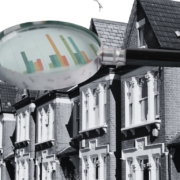The Office for National Statistics (ONS) revealed today that Britain has recorded the sharpest fall in inflation since August, with a drop in the annual rate to 8.7% in April.
It marked a decline from 10.1% in March, as UK inflation peaked at 11.1% in October.
According to the data from the ONS, electricity and gas prices contributed about 1.4 percentage points to the fall in the annual inflation rate.
A recent report from Nationwide has found that the average house prices rose 0.5% last month following seven consecutive falls from September.
The 0.5% rise means the average price has increased to £260,441, up from £257,122 in March. This has lifted the annual rate of house price growth to -2.7%, from -3.1% in March (the biggest fall since 2009), marking a return to composure in the market following the chaos of last autumn’s mini-budget.
In line with the findings from Nationwide, Zoopla reported at the start of April that there was a greater supply of houses on the market, 65% more than a year ago, as the average estate agent has 25 homes for sale compared to 14 in 2022.
Zoopla reported that the number of new sales agreed had risen 11% compared to 2019.
Despite the calls from forecasters for the market to crash by 20% this year, it remains resilient, which is a testament to its historical stability and believes the fall in inflation could further aid the property market and house prices.
As inflation recently stood at a 40-year high, the impact of the rising cost of living caused many first-time buyers to delay their dreams on stepping onto the property ladder.
The average house price-to-earnings ratio hit a record high in the third quarter of last year, with the average home costing almost seven times the typical salary, according to the Nationwide Building Society.
However, the recent fall in inflation could stabilise house prices and offer first-time buyers more opportunities to buy their first home.
David Hannah, Chairman at Cornerstone Group International, comments:
“Unsurprisingly, we have seen a fall in house prices at the start of 2023, however we did see a rise in prices in April, highlighting a return to stability in the UK property market.
The news that the inflation rate has witnessed its sharpest fall since August bodes well for the second half of the year for the housing market.
The knock-on effect will mean interest rates on mortgages will fall back to a reasonable level and, as a result, this will entice first-time buyers back to the market, thus increasing market activity and confidence.
I have always said that the UK property market has tended to be more stable than any other global property market, and if the rate of inflation continues to fall, I have no doubt we will see a return to confidence and stability for the second half of 2023 which I believe we are already starting to witness.
Throughout the end of last year, record house price growth and inflation hitting a 40-year high impacted everyone looking to buy a house, with first-time buyers particularly affected.
However, with inflation falling, property prices stabilising and new mortgage products being offered specifically targeted towards helping first-time buyers purchase a home, I think there is light at the end of the tunnel.”
Susannah Streeter, Head of Money and Markets, Hargreaves Lansdown, comments:
“Inflation has soared up like an eagle and taken a ferocious bite out of our standard of living, but it’s coming down at a snail’s pace and leaving a sticky trail of prices in its wake.
Growing at 8.7% in the year to April the growth in headline consumer prices was higher than expected and more than quadruple the Bank of England’s target.
More worryingly, core inflation, which strips out volatile food and energy prices crept back upwards to 6.8%. It shows that the price spiral is still proving to be a stubborn beast to conquer for the Bank of England.
Lower wholesale energy prices have finally started to feed through and should propel inflation lower in the second half of the year.
But it’s still unclear just how far and how fast inflation will fall. Although the jobs market is loosening up a bit, with more of the inactive masses returning to work and vacancies falling, the numbers of long-term sick have risen again.
It means the Bank of England’s worries about the fight for labour pushing up wages hasn’t eased off much.
Private sector pay grew 7% in January to March, but wages are still playing catch up with inflation and further pressure for more generous salaries is set to be applied.
Policymakers worry that fatter pay packets will be passed on by companies in the form of higher prices.
Another rate rise may have the effect of a herd of rhinos trampling over an economy, which is only just seeing some green shoots appearing as the forecast recession recedes.
But policymakers don’t have many other strategies to deploy right now to herd inflation in the right direction.”
Bradley Post, MD of RIFT Tax Refunds, comments:
“Despite an unexpected increase at the start of the year, the rate of inflation has continued to ease over the last few months, albeit it remains slightly higher than widely anticipated.
This will be welcome news to the many households who are still feeling the squeeze of the cost of living crisis, but who should now see a reduction in the previously high running costs of their home.
While the reduction in these core household costs has been offset by increases in recreation and culture, alcohol and tobacco, those struggling to make ends meet will be far better positioned to negotiate a hike in these non-essential outgoings.”
Jason Ferrando, CEO of easyMoney, comments:
“The latest look at inflation suggests that the Bank of England’s aggressive approach to curb inflation via a string of interest rate hikes is now starting to yield results, with the current rate of inflation dropping below 10% for the first time since August of last year and now at its lowest since March 2022.
This latest reduction should also help to steady the ship with respect to the property market and the cost of borrowing, with many mortgage lenders expected to now reduce rates.
In doing so, we should see a boost to homebuyer sentiment, which in turn, should help to breathe new life into the market and maintain the ongoing growth seen with respect to house prices.
All eyes will now be on the Bank of England and how they choose to proceed come the end of next month.
While we’re heading in the right direction, the job certainly isn’t done yet and so a reduction to the base rate is far from guaranteed.”
Jean Jameson, Chief Sales Officer at Foxtons, comments:
“The London housing market appears to be facing a better 2023 than initially predicted as renewed confidence ignites demand from buyers and investors.
Our local offices are seeing increasing appetite for London homes, with 17% more viewings booked year on year in April.
This could be due to innovative products, such as Skipton Building Society’s “no-deposit mortgage”, which has enticed buyers to explore their options; or the steadying of mortgage rates supporting greater price alignment between buyers and sellers.”
Joshua Raymond, Director at online investment platform XTB.com, comments:
“This morning, we’ve seen investors move quickly to buy into the UK pound, continuing a bullish trend for the GBP since the start of May after data showed inflation was cooling but not at the pace originally expected.
UK inflation slowed significantly to 8.7% in April and whilst this is a positive sign that inflation is cooling fast, inflation remains far higher than market expectations.
Investors and economists had expected UK inflation to slow to 8.2% in April, so this is actually a disappointing data read and will keep pressure on the Bank of England with its interest rate decisions.
It’s now likely that the BoE’s MPC will move to hike UK interest rates by another 0.25% at its next meeting in June.
Unfortunately the question marks over the BoE’s credibility won’t go away with this data set with the UK central bank seemingly behind the curve on UK inflation yet again”
Jatin Ondhia, CEO of Shojin, comments:
“The severity of price pressures has left little room for complacency, yet today’s long awaited dip into single-digit figures will no doubt be met with a sigh of relief from investors.
For the first time in eight months, evidence that a corner has been turned appears more tangible and following the IMF’s upgrade to the UK’s growth forecast, the emergence of a more positive tone will be welcomed by many.
That being said, there is no escaping the fact that the economy still faces a long road to recovery.
With inflation figures set to stay above the Bank of England’s target for longer than anticipated, it remains to be seen whether further, tighter monetary policy may be needed.
There might be a sense of cautious optimism, but investors should continue to assess how well placed their portfolio is to deliver on their short-, medium- and long-term goals, with the challenges of inflation and higher interest rates unlikely to dissipate this year.”
Chieu Cao, CEO of Mintago, comments:
“While it’s encouraging to see inflation falling, the financial burden faced by Britons is set to remain steadfast, and many people will feel like their finances are spiralling out of control.
Ultimately, there is no quick fix.
Yet with Mintago’s research finding that just 29% of employees have received financial wellbeing support from an employer that has actually improved their financial situation, it is blatantly clear that millions of individuals are being under-supported. Something needs to change, and fast.
Employers cannot just talk the talk about financial wellbeing, but they must also walk the walk.
Nor can they rely on a one-size-fits-all approach to providing financial wellbeing support.
Instead, employees must be given access to robust, meaningful support measures suited to the current economic climate; measures that, crucially, meet the unique needs of each and every individual.”
Commenting on falling inflation but the potential risk of further central bank policy failure, Charles White Thomson, CEO at Saxo UK, said:
“The status quo in the UK is increasingly painful and uninspiring – this should not be about celebrating falling inflation or the avoidance of a technical recession.
The UK continues to underperform its key counterparties and have underserved the majority and their aspirations.
We are now in an economic danger zone, pincered between public enemy number one/ inflation, a 19% increase in food and non-alcoholic beverages which reaffirms the cost of living crisis, and a consumer saddled with outsized debt that was once cheap.
The risk for further policy failure is real and the stakes are getting increasingly high.
The conundrum facing the UK is more than just beating public enemy number one, or inflation, it is about defeating the high tax and low growth loop and the lovers of the status quo or managed decline.
In an attempt to remove the politics and infighting, I prefer to continue referring to the UK as a PLC.
My resounding conclusion from the UK PLC’s recent financial statement – or budget – is that the management team are in an unenviable position in that there is little wiggle room for large change.
The UK PLC is effectively in a financial straitjacket with constraints including: £2.4 trillion public debt and all the servicing costs this entails, tax to GDP levels approaching record highs or 37.5% and corporation tax moving to 25% from 19% for financial year 2023/24.
Financial outlook statements for generations of UK PLC management have concentrated on the status quo as opposed to a more dramatic plan to seriously kick start growth, confidence, and the all-important upside this brings.
We have an advantage in that UK PLC is the sixth largest global company or economy in the world with all the scale and reach that this brings.
This is about a bold and large plan to ensure that we deliver on its full potential and unleash the prosperity that a large part of the UK shareholders want.
This would include making Brexit work, tackling the lack of productivity including the regional inequality gap which has entrenched itself since 2008, an overhaul of the corporate and individual tax structure making the UK a highly attractive place to do business, and having an open an honest debate about the sacred cows including the NHS.
The alternative to a bold and wide changing economic plan, which is not purely based on industrially low interest rates and quantitative easing, is continued stagnation and underperformance. This will not be easy, but the alternative is to sell out the next generation which should never be a consideration.”
























Comments